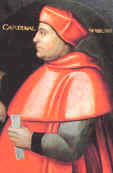Cardinal Thomas Wolsey was born in c1473 and died in November 1530. Wolsey was Henry VIII’s most important government minister who acquired much power which ended only after he failed to secure for Henry a divorce from Catherine of Aragon.
|
|
Wolsey was the son of a butcher and cattle dealer. He had a relatively comfortable upbringing and was educated at Magdalen College, Oxford University. Wolsey decided on a life devoted to God and he joined the church. He held a number of private chaplainries but he soon came to the attention of Henry VII as Wolsey was quickly identified as a man who had excellent managerial skills with a very good grasp of detail. Wolsey was also a very keen worker. In 1507, he was appointed Henry VII’s chaplain.
Wolsey continued to serve at court when Henry VIII succeeded his father in 1509. Wolsey received support at court from William Warham who was Archbishop of Canterbury from 1503 to 1532 and Chancellor from 1504 to 1515.
However, Wolsey quickly outgrew this support and he became the unofficial royal secretary. This position gave him almost daily contact with Henry VIII who rewarded the hard work and dedication Wolsey showed towards him by giving him numerous religious titles that were to finance the luxurious lifestyle Wolsey was to have. He was appointed a bishop for Lincoln, Bath and Wells, Durham and Winchester; an abbot for St Albans and Archbishop of York. He was also appointed Chancellor in 1514 and held that position until 1529. In 1515, Wolsey was appointed a cardinal and in 1518 he became a “Legate a latere” which made him a special and permanent representative of the pope. This position gave him huge power of the church in England at the time – far more power than Warham had as Archbishop of Canterbury.
When in London, Wolsey lived in York Place (now gone but where Whitehall now stands) and he also owned Hampton Court as a country residence. His luxurious lifestyle made him many enemies at court but he remained safe because of the support of the king.
As Chancellor, Wolsey dominated the Royal Council. He got to know who could be trusted and who could not. The nobility had been severely weakened under Henry VII and tried, at times, to resurrect their old power in the early years of Henry VIII’s reign. Wolsey ensured this did not happen and he used his position to tame the aristocracy. Such loyalty and devotion brought its rewards. Wolsey was, at times, the government of the country. Henry VIII had little time for the boredom of day-to-day government business as he was too busy hunting etc. This was left to Wolsey. The king decided on policy and Wolsey enforced and shaped it. However, from Wolsey’s point of view, he was always the servant to his master, Henry VIII.
Wolsey did a great deal to reform the legal system in England. It was modernised and, ironically, the power of the Church courts was reduced as the power of the Star Chamber and the common law courts was increased. The government was run effectively as would be expected from such a man.
However, despite being Chancellor, Wolsey had a poor knowledge of financial issues. He failed to use his position to develop England’s overseas trade and he failed to ensure that royal revenue increased at the same rate as the king’s spending. The economy of England was changing in the early Sixteenth Century – the so-called Price Revolution – but Wolsey failed to understand the complexities behind this change.
In foreign affairs, Wolsey supported Henry’s campaigns against France. He also had as a priority the security of England from European threats. However, he failed to be Europe’s great power-broker simply because England did not have enough financial power to have this position.
Wolsey’s fall from grace was over his inability to persuade the pope that Henry should have a divorce from Catherine of Aragon. Henry believed that Wolsey, as “Legate a latere”, had the necessary influence in Rome to secure his much wanted divorce. When Wolsey failed to do this, his position at court was doomed.
On September 22nd 1529, Wolsey was dismissed as Chancellor. By the end of October, he was sacked from his bishopric in Winchester and as Abbot of St Albans. The influential Boleyn family – Henry wanted to marry Anne – persuaded Henry that Wolsey should be removed from London. In April 1530, Wolsey arrived in York as Archbishop of York. He had been appointed Archbishop of York in 1514. Sixteen years later he visited the city for the first time!
Henry’s anger at Wolsey’s failure to get a divorce became more intense and he ordered his arrest which happened in November 1530. Wolsey was meant to be locked up in the Tower of London. However, he died during the journey from York to London at Leicester Abbey on November 29th 1530.
Related Posts
- Cardinal Thomas Wolsey was born in c1473 and died in November 1530. Wolsey was Henry VIII's most important government minister who acquired much power which…
- Cardinal Wolsey and Henry VII's relationship What relationship did Henry VIII have with Cardinal Wolsey? Clearly Henry was the master while Wolsey was his…
- Cardinal Wolsey always maintained that he served Henry VIII to the highest levels. Wolsey’s fall was primarily due to his failure to get Henry the…
